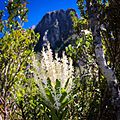White waratah facts for kids
Quick facts for kids White waratah |
|
|---|---|
 |
|
| Scientific classification | |
| Genus: |
Agastachys
|
| Species: |
odorata
|
The Agastachys odorata, often called the white waratah, is a special plant. It's the only type of plant in its group, called Agastachys, which belongs to the protea family. This plant is an evergreen shrub, meaning it stays green all year round, and can sometimes grow into a small tree.
You can only find the white waratah in western Tasmania, Australia. It loves to grow in moist, open areas like heaths and button grass sedgelands. It usually prefers soil that drains well but isn't very rich in nutrients. While it's mostly a shrub, it can become a small tree in some rainforests. The most white waratahs are found along Tasmania's south coast. Its leaves are dark green, smooth, and a bit thick, almost like a succulent (a plant that stores water). In January and February, it produces many white flowers that grow in tall spikes, about 8 to 12 centimeters high, at the ends of its branches.
Discovering the White Waratah
A Scottish plant expert named Robert Brown first described the Agastachys odorata in 1810. The plant still uses the name he gave it today.
Scientists group plants into families and subfamilies based on how they are related. For a long time, the Agastachys plant was grouped with other plants from Australia and New Caledonia. But in 2006, two scientists, Peter H. Weston and Nigel Barker, looked closely at the relationships of the Proteaceae family. They used information from the plants' genes and their physical features. They found that Agastachys and another plant called Symphionema are very closely related. They are like "sister" plants that branched off early from the main Proteaceae family tree. Because of this, they are now placed in their own special group called the subfamily Symphionematoideae.
Plant Health Concerns
The white waratah is known to be very sensitive to a plant disease called Phytophthora cinnamomi dieback. This disease is caused by a type of water mold that can make plants sick and even kill them.
Images for kids
See also
 In Spanish: Agastachys odorata para niños
In Spanish: Agastachys odorata para niños





